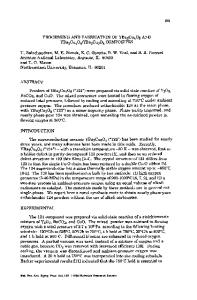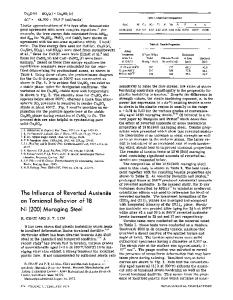Reaction kinetics of Cu 2-x S, ZnS, and SnS 2 to form Cu 2 ZnSnS 4 and Cu 2 SnS 3 studied using differential scanning ca
- PDF / 1,003,651 Bytes
- 6 Pages / 612 x 792 pts (letter) Page_size
- 40 Downloads / 365 Views
Reaction kinetics of Cu2-xS, ZnS, and SnS2 to form Cu2ZnSnS4 and Cu2SnS3 studied using differential scanning calorimetry Elizabeth A. Pogue, Melissa Goetter1 and Angus Rockett1,2 1 University of Illinois Urbana-Champaign, Department of Materials Science and Engineering, Champaign, IL 61801, U.S.A. 2 Colorado School of Mines, Department of Metallurgical and Materials Engineering, Golden, CO 80401, U.S.A. ABSTRACT Differential scanning calorimetry experiments on mixed Cu2-xS, ZnS, and SnS2 precursors were conducted to better understand how Cu2ZnSnS4 (CZTS) and Cu2SnS3 form. The onset temperatures of Cu2SnS3 reactions and CZTS suggest that the ZnS phase may mediate Cu2SnS3 formation at lower temperatures before a final CZTS phase forms. We also found no evidence of a stable Cu2ZnSn3S8 phase. The major diffraction peaks associated with Cu2ZnSnS4, and Cu2SnS3 (overlaps with ZnS, as well) began to grow around 380 °C, although the final reaction to form Cu2ZnSnS4 probably did not occur until higher temperatures were reached. An exothermic reaction was observed corresponding to formation of this phase. There was some variability in the onset temperature for reactions to form Cu2SnS3. At least 5 steps are involved in this reaction and several segments of the reaction had relatively reproducible energies. INTRODUCTION Cu2ZnSnS4 (CZTS) solar cell efficiency improvements have proven difficult since 2013 [1], suggesting that new approaches informed by the system’s fundamental thermodynamics and common kinetic routes is needed. Cu2SnS3-based solar cells are also being investigated as another non-toxic, Earth-abundant absorber layer option, although efficiencies do not yet match those of CZTS-based cells. Consequently, understanding how either of these phases form might help explain some of this performance gap. The energy landscape for the Cu-Zn-Sn-S system is not fully understood. Experimental data exist for the ZnS, SnS2, CZTS, and Cu2S phases (see Figure 1). A calculated Cu2SnS3 formation enthalpy has been reported [2]. The formation enthalpy of monoclinic Cu2SnS3 has been calculated, although no experimental results exist. Unfortunately, the calculated formation enthalpy for Cu2SnS3 is less negative than the experimental formation energy for its constituent binary sulfides, Cu2S+SnS2. This is likely due to a systemic calculation error. The magnitude of that error can be estimated to be -0.5 eV by comparing experimental and calculated formation energies of SnS2 and Cu2S. This suggests that the Cu2SnS3 phase has a higher (less negative) formation energy than CZTS. One would not expect CZTS to decompose into ZnS and Cu2SnS3 due to their formation energies. Several groups have conducted high-temperature x-ray diffraction (HT-XRD) investigations to understand how CZTS forms with temperatures ranging from slightly below 300 °C to 570 °C. According to Schurr et al., Cu2-xS and SnS2 react between 415 and 542 °C to produce Cu2SnS3. This then reacts with ZnS near 572 °C to form the final CZTS phase [3]. For Cu-poor compositions, Cu4SnS
Data Loading...











